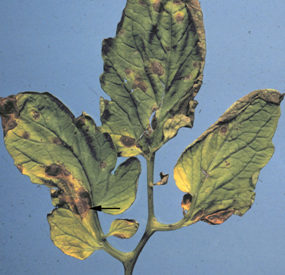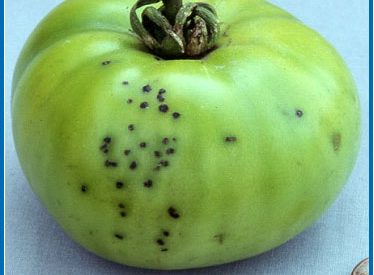What is tomato spotted wilt?
Tomato spotted wilt is a common viral disease of worldwide distribution that can affect over 1000 plant species. Economically important hosts include a wide range of vegetables, fruits, field crops, and ornamentals. Many weeds are also potential hosts. Tomato spotted wilt is especially important in greenhouse production where it can cause significant economic losses in horticultural and floral crops. In potato production, tomato spotted wilt is uncommon but of enough concern that routine monitoring for the disease in greenhouse and field settings is warranted.

What does tomato spotted wilt look like?
Symptoms of tomato spotted wilt vary widely depending on host species, host variety and when during development a plant is infected. Typical symptoms on leaves include yellow, brown or black ringspots (i.e., ring-like areas of discolored tissue). On some hosts, the ringspots can form a target-like pattern. Distorted leaf growth can also be a typical symptom.
On potato leaves, tomato spotted wilt can lead to necrotic (i.e., dead) areas with or without yellow haloes. These symptoms can resemble symptoms of early blight. Black streaks on petioles or stems and branch tip dieback are also common symptoms on potato (as well as other hosts). Potato tuber symptoms include surface rings or dark patches, and internal discolored patches, rings, spots or flecks.
Where does tomato spotted wilt come from?
Tomato spotted wilt is caused by Tomato spotted wilt virus (TSWV), which is closely related to Impatiens necrotic spot virus (INSV), the cause of impatiens necrotic spot. TSWV is found in the sap of infected plants and is most commonly spread by thrips. At least eight thrips species can be involved in TSWV transmission. Thrips larvae acquire the virus as they feed on infected plants, then transmit the virus as they move to and feed on healthy plants. Once thrips acquire the virus, they can transmit it for their entire lifespans. The severity of tomato spotted wilt depends on the size and activity of thrips populations at a location, as well as on the number of infected plants (often weeds, but potentially infected potatoes as well) serving as reservoirs for the virus. TSWV can also be transmitted mechanically (e.g., on tools used to trim branches or cut potato tubers), but this method of transmission is much less common than transmission by thrips.
How can I save plants with tomato spotted wilt?
There is no known cure for tomato spotted wilt. Infected plants should be removed and destroyed to eliminate a reservoir for the virus that can subsequently contribute to spread to other plants. Infected plants can be burned (where allowed by local ordinance), deep buried or hot composted.
How can I avoid problems with tomato spotted wilt in the future?
Prevent introducing TSWV and thrips into your greenhouse by carefully inspecting any new plants for potential problems. Test suspect plants for TSWV using dipstick tests (available from Agdia, Inc.) or by submitting a sample to the UW-Madison Plant Disease Diagnostics Clinic. Remove and dispose of any infected plants.

To prevent new infections via thrips, remove weeds in and outside of greenhouses to eliminate TSWV and thrips reservoirs. Place 400-mesh screens on vents to limit thrips movement. Also limit thrips movement on clothing by avoiding colors (e.g., pink, blue, yellow, white or green) that can attract thrips. Monitor for thrips using blue and yellow sticky cards placed above plants throughout the greenhouse and near doors and vents. Use chemical and/or biological control products to control thrips. See Managing Thrips in Greenhouses for details on what products to use and when to use them. Multiple applications will likely be necessary because thrips eggs are not killed by insecticides. If you find plants that you suspect are infected with TSWV, remove and dispose of these plants immediately.
To prevent mechanical transmission of TSWV, be sure to routinely decontaminate any items (e.g., pruners, knives, pots, work surfaces) that come into contact with plants by treating them for a minimum of one minute with a solution of one of the following:
- 2.75 tablespoons Alconox® (a type of lab detergent) plus 2.5 tablespoons sodium dodecyl sulfate (SDS) [also known as sodium lauryl sulfate (SLS)] in one gallon of water, or
- 14 dry ounces of trisodium phosphate in one gallon of water.
In field settings, tomato spotted wilt does not appear to be a significant problem on potato (although it can be a significant problem on other crops). Use of resistant or tolerant potato varieties may reduce yield loses, but unfortunately there is little information on which potato varieties are resistant/tolerant to the disease. Removing symptomatic plants can reduce potential reservoirs of TSWV, but may not be feasible. More important in field settings may be to keep weeds under control. Current research suggests that TSWV does not persist long-term in the field unless there are perennial weeds to serve as TSWV reservoirs.
For more information on tomato spotted wilt:
Contact the University of Wisconsin Plant Disease Diagnostics Clinic (PDDC) at (608) 262-2863 or pddc@wisc.edu.
Authors: Lauren Pryor and Brooke Babler, UW-Madison Plant Pathology
Last Revised: 03/02/2024
D-number: D0117
References to pesticide products in this publication are for your convenience and are not an endorsement or criticism of one product over similar products. You are responsible for using pesticides according to the manufacturer’s current label directions. Follow directions exactly to protect the environment and people from pesticide exposure. Failure to do so violates the law.
Thanks to Tom German, Clover Spacek and Denise Worzalla-Rocha for reviewing this document.
A complete inventory of UW Plant Disease Facts is available at the University of Wisconsin-Madison Plant Disease Diagnostics Clinic website: https://pddc.wisc.edu.
Send a Plant Sample for Analysis
Be cautious when self-diagnosing plant health issues. Very few diseases can accurately be diagnosed by eye.
Contact the UW Plant Disease Diagnostics Clinic (PDDC), and for a small fee, clinic staff can examine a plant, determine the cause of the disease/disorder, and provide advice on how to control or prevent the issue.
Download Article





 Tomato Disorder: Physiological Fruit Problems
Tomato Disorder: Physiological Fruit Problems Early Blight
Early Blight Bacterial Speck of Tomato
Bacterial Speck of Tomato Bacterial Spot of Tomato
Bacterial Spot of Tomato


